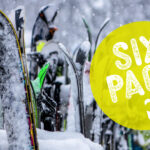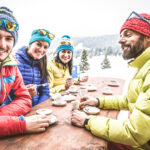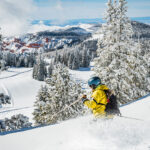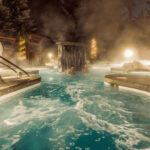Alpine touring in the Gaspé’s Chic-Choc Mountains left three boys from Ontario in awe of Eastern powder.
STORY AND PHOTOS BY ADAM BUITENHUIS
Chest-deep in powder and struggling to pull myself to the surface, frustration hadn’t quite morphed into panic. Acquiescent and exhausted, I admitted defeat and yelled to my ski-buddy Craig who was still in his skis. “Hey! Need some help here!” Craig proved to be better at observing than physically helping, but it was a relief knowing that at least someone knew where I was…clawing my way out of the quicksand-like bottomless snow.
When we tested the snow depth later, my 2.5m avalanche probe didn’t reach bottom. “These are typical depths for this area,” our mountain guide Charles told us matter-of-factly. “We just measured 230 cm in the next chute over.”
I found myself in this difficult situation by stepping off a packed-out snow shelf while searching for a better place to take photos of buddy number two, Dustin. He was about to rip some turns down a couloir called Legends after a long, deep and exposed skin up. I was wishing I had been up there about to grab first tracks but it was all picture perfect and I also didn’t want to miss the shot.
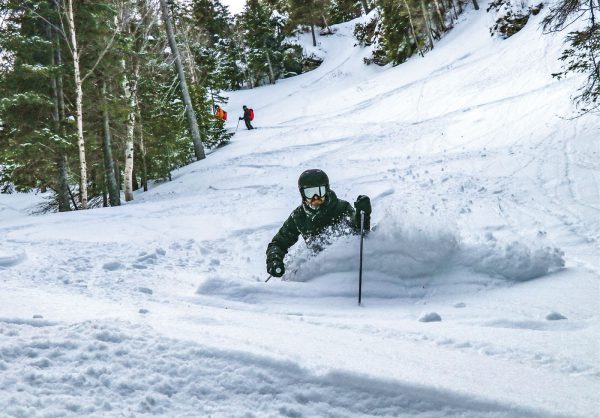
Surrounded by exposed, wind-blown rocky chutes, and above tree line, we three boys from Ontario agreed repeatedly that our wintry alpine environment felt more like Western Canada. But we were nearly on the opposite coast, in les Chic-Chocs, a mountain range parallel to and about 30 km south of the St. Lawrence River on Quebec’s Gaspé Peninsula. The region is home to a raw alpine environment still little discovered by most Canadians but fabled by backcountry skiers.
Although the Gaspésie is home to seven local ski areas (Pin Rouge being the biggest with a vertical of 450 metres), its treasure trove of natural snow is also home to the only commercial cat-skiing east of the Rockies. And thus the reason we drove almost 15 hours and 1,300 km from Toronto.
It’s miraculous that Craig, Dustin and I even made it to our destination on this road trip. How does that saying go, bad luck comes in threes? Between shorting out the Land Rover’s electrical system, losing the gas cap only to find it wedged into the roof rack 100 km later, and overheating in a remote part of Quebec with the sun setting and zero cell phone signal, we faced our share of challenges along the way.
Craig had volunteered his utilitarian vehicle for our road trip to the Chic-Chocs, the northernmost point of the Appalachian Mountain range. We were riding in style, “army style,” in his rare Land Rover Defender on this epic boys’ road trip. The truck evidently was a head turner, particularly by les Sûreté du Québec after Craig blew past the provincial po-po at a speed I can’t tell you. But our luck seemed to change suddenly when the observing officer pulled up beside us; he seemed to simply admire our magnificent tank before speeding off himself.
Our trio of time-flexible entrepreneurs turned the Landy into a mobile office, and along the way Drinks Tactician Craig could regularly be heard on his cell discussing various projects like bringing 9,000 litres of rum into his vodka facility for bottling. Meanwhile, Dustin remained fully plugged into his laptop, hammering out social media plans, co-ordinating staff for his digital strategy and media company, and landing corporate contracts on the go.
After a comfy sleep at a chic auberge in the heart of old Quebec City, we left some loud American tourists behind to head for the legendary hostel and cat-skiing operation, Chic-Chac, still a seven-hour drive away. We rolled into Murdochville at twilight but it wasn’t hard to find the only ski operation in town. We found a group of satiated-looking skiers milling around, hauling gear off two of the operation’s three snowcats since they had just arrived from a clearly great day of skiing. We were directed toward a mobile trailer where a friendly receptionist greeted us, with keys in hand to a house in town.
The popular Chic-Chac has been buying up “shacks” in town to use as accommodation for its guests. Humorously, we should have actually read the “what to bring” list because we spent the next couple of days sharing the one tiny tea towel provided for our showers. As to be expected in hostel-style accommodation, there’s no hot tub and plastic tablecloths are de rigueur in the mess-hall-style dining area. No apologies. It’s a destination for hard-core skiers—and it was perfect.
Everything happens organically here, even our impromptu interview with owner Guillaume Molaison, a 36-year-old entrepreneur with a Steve Jobs-size vision of how he and his wife, Eloise, could transform this once-booming copper mining town into a mecca of backcountry skiing and tourism. We were mesmerized by the story of his arrival 16 years ago when 70 per cent of the people voted to cash out by taking a government payout to move and close down the town. His attitude and vision attracted like-minded millennials from all over to be a part of his family and help create what Gui calls a “custom-made backcountry playground, built by riders.”
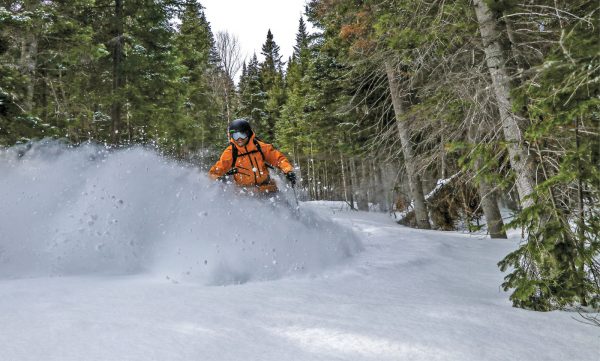
On our first day we were treated to two experiences on Gui’s first backcountry building project, Mont Porphyre. First by day, then by night. It was only a 20- to 30-minute cat ride to get to the mountain summit from the main chalet. With 250-300m of vertical, Porphyre’s slopes are tougher than expected (30-40 degrees), lined with stubby coniferous undergrowth that can receive up to seven metres of snow a season. Our guide, Alexey, was a self-professed poutine-eating, cigarette-smoking, Québécois ski bum, but as Alexey described, “on fast forward.” In the small-world department, Dustin learned Alexey also happened to be a friend of his dad when they had both been ski instructors in Jasper years ago.
With Gui driving and Alexey as our guide, we drove to the summit of Mont Porphyre. As the cat idled down in the lightly falling snow, we stepped out wide-eyed onto the grey windswept, barren peak overlooking the town. Alexey pointed out the remnants of what the old mining operation did to the surrounding geography. The land was ripped barren of vegetation and bore scars that will take a long time for Mother Nature to heal. After clicking into our skis, we pushed off and dropped into some lovely boot-top powder among well-spaced conifers. The skiing was fun and easy among short, open vegetation. As we made our way down, we could see the cut runs on Miller Mountain, the next face. The town ski hill, with its one T-bar and 32 runs, is now owned by Chic-Chac. It’s open on weekends, the occasional Friday—and anytime for groups of 25 or more.
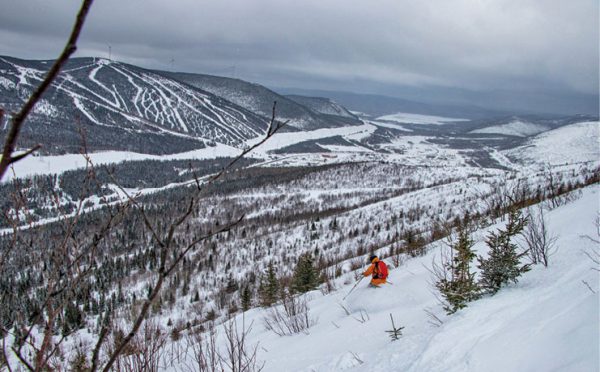
The best surprise we had was cat-skiing at night with headlamps on Mont Porphyre. Our tracks from earlier in the day were almost non-existent now with the new snow in the light of our lamps. We found some deep pockets of silent powder to launch off of, with the playground feeling even more intense at night. With no one else around, we felt as if somehow we were breaking the rules. Adventure is deep in the heart of this place.
The next day we tackled Mont York, the pièce de résistance of Chic-Chac’s 2,000+-hectare playground on exclusive lease with the Quebec government. Most notable was “Le Parc,” created by thinning trees to perfection and in so doing, creating various features like jump platforms—fitting given the surrounding powdery environment on which to land. As far as we knew, this was another first in the backcountry industry.
The cat was near full on our second day with a group of six buddies from university, now in their 40s, a couple of snowboarders from the Maritimes and us. More fresh snow had arrived overnight to wipe the slate clean and again we remained over the knees in deep bliss. Lap after lap, the cat would dump us out directly at the top of steep and untracked routes. Trees were spaced out in some areas for those who wanted room for more open turns; the braver ones found deeper, truly untouched turns in tighter spaces. After more than a dozen runs, the light started to fade and the entire group grew long faces. But with a bit of coaxing and whining, the guides huddled together and an encore was announced to great cheers. Our last run with Auberge Chic-Chac was as memorable as all the others.
––––––
It was time for the adventure to push on, so after tossing our belongings into the Landy, we drove west for an hour and a half into the heart of Gaspésie National Park and arrived at a swank-looking hotel, Le Gîte du Mont-Albert, a four-star oasis with high post-and-beam ceilings and stone fireplace lounges. As we savoured a five-course meal of fine French cuisine paired with wine, light snow fell outside. Mont Albert’s peak loomed overhead in the dark sky, its windswept peak and big steep chutes calling our names. Over dessert, we remembered collectively that we wouldn’t have the benefit of external mechanics on this part of our journey since cat-skiing had been discontinued in the park. We had to earn our turns, “à les puristes,” Dustin joked.
Early the next morning, we met up with our guides Charles (Chip) and Guillaume at the Gaspésie National Park Discovery Centre close to the hotel, where the five of us hunched over the map of mountain ranges and planned our day. There was a lot of terrain to choose from, with descents of up to 500 metres with names like Freak, Super Freak, S-bend and Legends. Dustin was looking for terrain as challenging as possible, while Craig and I were feeling a little less sporty. Chip made the call that we would head into the Mines Madeleine range, an area that their guiding outfit, Ski Chic-Chocs, had exclusive rights to begin tours with snowmobiles. Needless to say, they were necessary to reach the distant trailhead that would lead to untouched terrain.
After a thorough safety briefing and transceiver training, we jumped onto the sleds that would take us deep into the mountains. We felt sheepish passing those out for a day of cross-country skiing as we drove noisily past them en route to where we would begin skinning up.
“Holy shit! Look at that!” Dustin blurted out excitedly. After our hour sled ride, the terrain had opened up into an alpine amphitheatre, exposing us to what we were about to skin up. Huge. To all three of us, this was previously unimaginable in the east. Gnarly chutes, wind lips, steep exposed rock above the tree line… Chip explained how the extreme weather keeps the peaks so barren. He also told us that the previous night saw winds exceeding 140 kph and pointed to an open rocky bowl void of snow that was typically waist deep. “The good news is,” said Chip, “that snow had to go somewhere—we just need to find it!” For us, it was a rocky couloir that became visible as our skins glided across the smooth exposed lake ice that we had to cross to begin our uptrack.
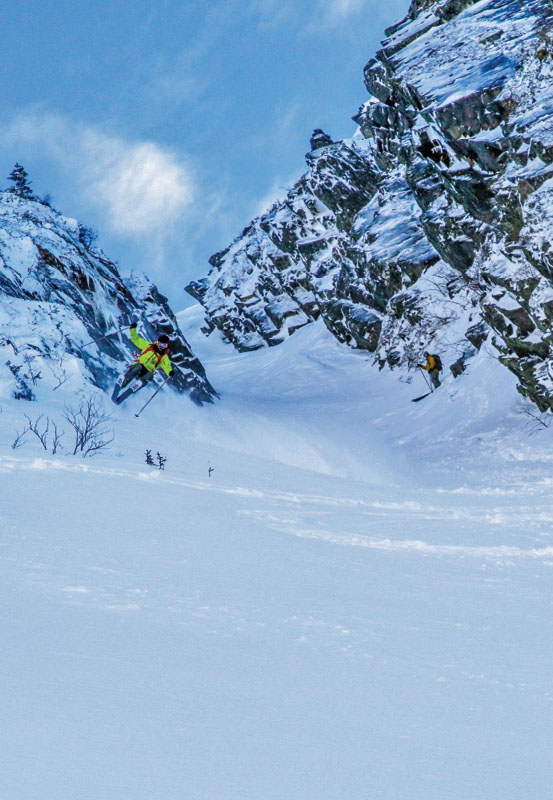
Fearing a slide, Chip and Gui bailed on our first choice of chutes, but they were like bloodhounds sniffing out the best powder and taking notes of conditions and weather along the way. After five ascents, we finally came to what we really wanted to ski, Legends Couloir. When the slope got too steep, we hoofed the rest of the way by climbing, making us feel exposed and exhausted in this exhilarating alpine environment.
We pushed our limits that day. By the time we got back to the sleds, Dustin was prostrate on the snow, moaning for 15 minutes. Luckily Craig, the drink tactician, produced a flask of Black Russian and expertly administered it down Dustin’s throat.
After such a momentous day, our guides were kind to us the second day and allowed us an adventurous but easier climb through a serene wooded backcountry with pines draped in moss and views of the surrounding mountain range. Our run was a beautiful open area the width of a couple of football fields, ominously called “the slide.” We felt relieved to learn its name came from a massive mudslide off-season that wiped out a huge section of the mountain but left skiers with beautifully casual deep turns all the way down. Combine that with a baguette stacked with meat and cheese for lunch and some great friends and you have a magical way to end a ski trip. All that was left was our 14-hour-drive home.
